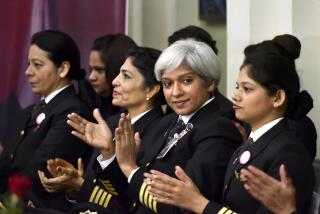Miniature Cameras Could Revolutionize Plane Safety
- Share via
LITTLE ROCK, Ark. — New technology allowing near infinite vision in a camera the size of a pencil eraser could enable airlines to better detect safety problems and determine the causes of crashes.
Long a topic of discussion, the cameras are nearing production at a fledgling Arkansas firm that has on its board a former chairman of the National Transportation Safety Board.
Already, at least one commercial airline has ordered one of the miniature cameras for inspecting its jet engines. Vision Technologies Inc. also plans cameras that can be attached to wingtips and installed in cockpits to identify in-flight problems and record events for accident investigations.
“It’s one of the most exciting things I’ve seen, not only in aviation but in transportation generally,” said Jim Burnett, former NTSB chairman from 1982 to 1988.
The miniature digital camera is about one-quarter inch in diameter with a lens measuring 2 millimeters by 2 millimeters. It is constantly in focus, be it for an object one-half inch from the lens or something almost an infinite distance away.
“It can see as far as a human could see on the horizon,” said Robert Lee Thompson, founder of Vision Technologies.
It can also be controlled remotely and rotated full circle.
Originally used by surgeons, the camera can be used by airline mechanics to inspect the inside of engines without having to take them apart. It can be attached to the tools needed for repairs.
Burnett, now a transportation safety consultant, joined the Vision Technologies board in February. But his desire for cameras on commercial airlines goes back to one of his first NTSB investigations, when he said it could not be determined from data and audio recorders what pilots were referring to on an instrument panel.
The NTSB in February recommended video cameras for the cockpits of all turbine-powered planes not equipped with flight data recorders. The Federal Aviation Administration, which regulates the industry, is considering the recommendation.
The two agencies also have asked an advisory panel of industry and government experts to come up with recommendations on new flight data technology, likely including the use of cameras.
Officials at Vision Technologies, based in Rogers, hope the federal attention will be a catalyst for installing cameras on all commercial airplanes.
“The concept of having cameras on planes makes so much sense we should have done it a decade ago,” said West Doss, who quit as chief of staff for U.S. Rep. Asa Hutchinson (R-Ark.) to become president of Vision Technologies in January. “But the technology wasn’t necessarily available then, and we have it now.”
The nearly 2-year-old company plans to begin production in August on its cameras--targeted first for airline maintenance, Thompson said. The company anticipates a joint venture to produce other cameras that can be mounted on the outside and inside of airplanes, he said.
Similar cameras are being developed by Germany-based Vidair AG, which plans to unveil a prototype at an aviation exhibition in June, said Dillard Woodson, vice president of the company’s North American operations.
Another company called L-3 Communications also has developed a prototype for an airplane video recorder, but it is not near production, said Mary Gayle Wright, a spokeswoman at the company’s Sarasota, Fla., division.
The office of Arkansas Gov. Mike Huckabee said the state Science and Technology Authority is considering a $50,000 start-up loan for Vision Technologies. More state money could follow.
Versions of the camera can allow pilots--or maintenance crews on the ground--to monitor a plane’s mechanical parts while in flight.
In the case of Alaska Airlines Flight 261, an external camera could have let the flight crew view problems with the rear stabilizer, which controls the plane’s pitch, before the jet crashed into the Pacific Ocean off the California coast. All 88 aboard died in the Jan. 31 crash.
A camera also could have beamed images of the stabilizer to maintenance crews on the ground, who could have helped analyze the problem, Doss said.
“James Bond notwithstanding, no one can walk back there at jet airspeeds and take a look at it,” Burnett said. “The ability to do it with a camera . . . might have the ability to salvage the flight.”
Miniature cameras also could catch the formation of ice on wings before takeoff, or could show the position of the landing gear when a cockpit light indicates a problem, Burnett said. The only way to view the landing gear now is to fly up in another plane, he said.
Had a camera been installed in the cockpit of EgyptAir Flight 990, it might have been able to show what happened before the plane mysteriously plunged into the Atlantic Ocean last Oct. 31.
But the nation’s largest pilots’ union has several concerns about placing cameras in cockpits. The Air Line Pilots Assn. wants a law barring the release of videos to the public or the use of them in any punishments against pilots.
“It’s a privacy issue for us, and we absolutely oppose the installation of cockpit video recorders until protection provisions are in place to prevent the misuse of the information,” said Anya Piazza, a spokeswoman for the union that represents 51 commercial airlines in the United States and Canada and about 55,000 pilots.
Burnett said it is possible the camera could be focused only at the instrument panels, leaving pilots’ faces out of the picture. If that’s the case, Piazza said, the camera could provide a good supplement to flight data and cockpit voice recorders.
“The technology is there,” Burnett said. “It’s just a matter of putting it into mass production.”
More to Read
Inside the business of entertainment
The Wide Shot brings you news, analysis and insights on everything from streaming wars to production — and what it all means for the future.
You may occasionally receive promotional content from the Los Angeles Times.










